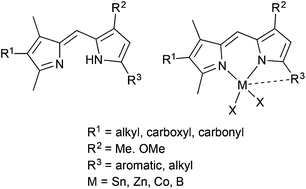Synthesis and antimalarial activity of prodigiosenes†
Abstract
Several analogues of the natural compound prodigiosin with modified A- and C-rings were synthesised as were some of their tin, cobalt, boron and zinc complexes. The antimalarial activity of these prodigiosenes was evaluated in vitro using the 3D7 Plasmodium falciparum strain. The presence of a nitrogen atom in the A-ring is needed for antimalarial activity but the presence of an alkyl group at the β′-position of the C-ring seems detrimental. Dibutyl tin complexes exhibit IC50 values mostly in the nanomolar range with equal or improved activity compared to the free-base prodigiosene ligand, despite the fact that the general toxicity of such tin complexes is demonstrably lower than that of the free-bases.


 Please wait while we load your content...
Please wait while we load your content...